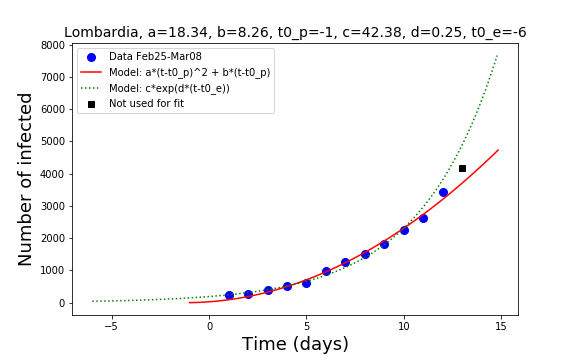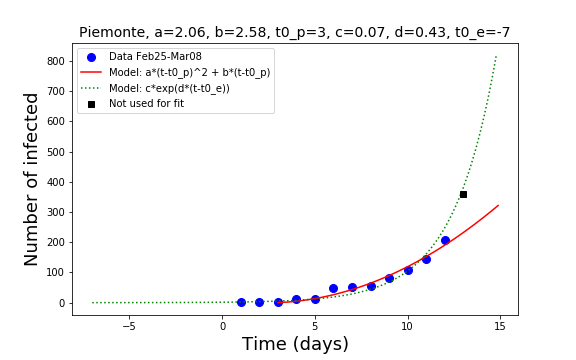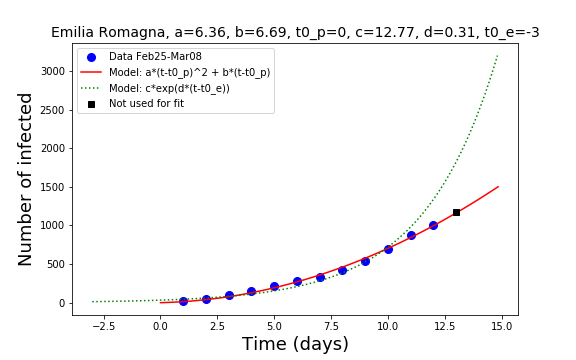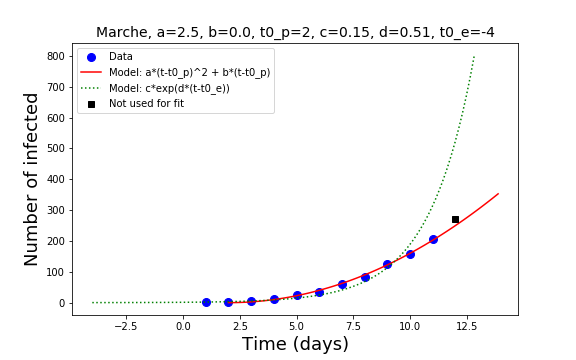After a long back and forth, the Italian government has taken very brave measures to ensure that no new hot spots will arise. Unfortunately, these measures will show their effect in two weeks and the large number of people who left the northern regions to reach the southern regions will create a social hopping effect in those regions.
Across the Italian regions mainly hit by the expanding virus, there are big differences that I would like to illustrate here.
Lombardia and Piemonte
In Lombardia we had the first big cases (patient 1, who seems to be recovering) and a very large expansion of the infection. Piemonte is a neighboring region with strong connections to Lombardia. Both regions are very rich and characterized by strong migration that makes people very mobile across the same region and towards all other Italian regions.
It is not surprising that for both of them the number of infected people grows exponentially since they are the regions where social hopping is very active. This exponential expansion will eventually end and become milder, but at the moment is putting the health system under strong pressure.
Emilia Romagna and Marche
Apart from the provinces in Emilia Romagna closer to Lombardia, these two regions have a relatively small social hopping and a smaller number of people traveling to different parts of the country with respect to Lombardia and Piemonte.
In both regions the number of infected individuals up to today follows a polynomial function with degree two of the time. Even though this is yet not the ideal condition, the examples of South Korea and Hubei teach us that this is the background for a further slowing down. With strong efforts to quickly identify the infected people, they will manage in two weeks to calm down the wave of infected.
Veneto
The policy taken in Veneto has been to test as many people as possible against the coronavirus and to test them as many times as it was necessary, especially the workers in the national health system (see this article in Italian). The systematic testing has eliminated so many people from the social contacts that the region Veneto enjoys a controlled growth of the number of infected individuals.
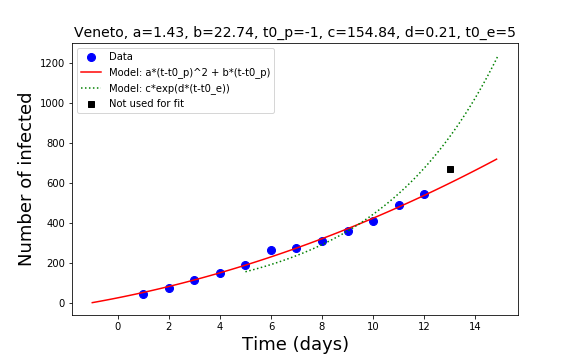
The growth is not linear, but the dependence on the quadratic term of the time is very weak. Under a linear condition, when steady state is reached (in about two weeks) the number of people needing intensive medical care will equal the number of people becoming immune and health again. This means that under these conditions the hospitalization will not increase. What can go wrong here is that the number of hot spots might increase when infected but still undetected people from other regions would transfer there. One can realize, by looking at the plot, that in the last four days there is a departure from linearity. The region Veneto should not relax its policy to avoid entering into the exponential phase that they have been able to avoid so far.
Italy as a whole
All regions in Italy are involved in the infection. So far, the southern regions have been much less involved than the northern regions. This may be pure chance. It is likely that the number of people going back to the South after the mobility restrictions in the North will create new hot spots through social hopping and this may change the situation in the south if the national health authorities do not intervene immediately with a policy similar to Veneto.

The data for Italy shows that the country has abandoned the exponential growth as a whole. However, the exponential behavior of Lombardia and Piemonte might take the lead and change this behavior.
How many people are infected?
I make the assumption that people who got infected today will be tested and detected within the next 10 days. If we take the best of the two models, namely the polynomial model of degree two as shown in the Italy plot, then we can extrapolate until day 28 (until March 18).
We find out that by this trend there are 18300 infected people in Italy today. This is 10000 more infected people than we have registered so far.
Although we cannot change this number, we can do something to avoid that this number increases too much: find all these people! Every one that has been found can be isolated to avoid contacts with healthy people. 18300 infected might seem an exaggerated number of people but it might be also an underestimate if the exponential trend of Lombardia and Piemonte continues to hold.
How many people will recover?
It may not seem obvious but the number of people who recover has to follow the same curve in time as the number of total infected people with a delay due to the average recovery time (probably 20 days) . There is a small difference due to mortality, but the curve of the recovered must grow as rapidly as the curve of the infected was growing 20 days before.
What shall the recovered people do?
I propose here that recovered people should be offered the possibility to work at the service of the state in a kind of payed civil service to help ensuring the fundamental functioning of services and institutions with a guarantee that they will not loose their jobs.
